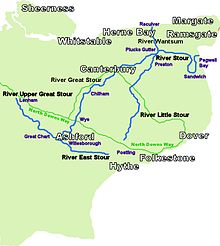West Stour, Kent
| River Stour | |
|---|---|

River Stour and Tributaries
|
|
| Basin features | |
| Main source | Lenham |
| River mouth | Pegwell Bay |
The River Stour /ˈstaʊər/ is the river in Kent, England that flows into the North Sea at Pegwell Bay. Above Plucks Gutter, where the Little Stour joins it, the river is normally known as the Great Stour. The upper section of the river, above its confluence with the East Stour at Ashford is sometimes known as the Upper Great Stour or West Stour. In the tidal lower reaches, the artificial Stonar Cut short cuts a large loop in the natural river.
The Stour has Kent's second largest catchment area (the River Medway having the largest). The lower part of the river is tidal; its original mouth was on the Wantsum Channel, an important sea route in medieval times. The river has three major tributaries, and many minor ones. For much of its length it flows in a generally south-west to north-east direction.
The historic city of Canterbury is situated on the river, as are the former Cinque Port of Sandwich and the railway town of Ashford. The route of the Stour Valley Walk follows the river.
The source, of what is known at that point as the Great Stour, is near the village of Lenham, within a short distance of the River Len, a tributary of the Medway. The source is at a high elevation close to the North Downs escarpment. At first the river flows south east in a narrow valley parallel to the escarpment and the Greensand ridge to the south, before breaking through the ridge near Hothfield into a broad valley. Three small streams enter from the north, having their headwaters on the close to Downs escarpment. Flood defences can turn this valley into a large lake and an embankment has had to be built to prevent overflow into the Medway catchment barely 100 metres away to the south. The river turns north east by the village of Great Chart in the direction of its outlet to the sea.
...
Wikipedia
